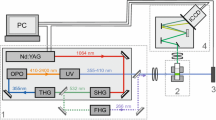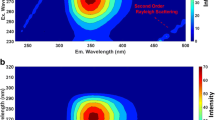Abstract
Time-resolved laser-induced fluorescence spectroscopy (TRLFS) is a powerful speciation technique for fluorescent metal ions and can be further improved by combining with multi-mode factor analysis such as parallel factor analysis (PARAFAC). This study demonstrates the applicability of TRLFS combined with PARAFAC for the speciation of uranyl (UO2 2+) in the presence of silicic acid (Si(OH)4). A series of TRLFS data with varied Si(OH)4 concentration was processed by PARAFAC, resulting in three factors corresponding to free UO2 2+, UO2SiO(OH) +3 , and UO2OH+. The stability constant of UO2SiO(OH) +3 was further optimized, based on the intensity profiles of the factors.


Similar content being viewed by others
References
Buffle J (1985) Complexation reactions in aquatic systems: an analytical approach. Ellis Horwood, Chichester
Collins RN, Saito T, Aoyagi N, Payne TE, Kimura T, Waite TD (2011) J Environ Qual 40:731–741
Saito T, Sao H, Ishida K, Aoyagi N, Kimura T, Nagasaki S, Tanaka S (2010) Environ Sci Technol 44:5055–5060
Ishida K, Saito T, Aoyagi N, Kimura T, Nagaishi R, Nagasaki S, Tanaka S (2012) J Colloid Interface Sci 374:258–266
Lukman S, Saito T, Aoyagi N, Kimura T, Nagasaki S (2012) Geochim Cosmochim Acta 88:199–215
Bro R (1997) Chemom Intel Lab Syst 38:149–171
Stumm W (1996) Aquatic Chemistry. John Whiley & Sons, New York
Jensen MP, Choppin GR (1996) Radiochim Acta 72:143–150
Andersson CA, Bro R (2000) Chemom Intel Lab Syst 52:1–4
Bro R, Kiers HAL (2003) J Chemom 17:274–286
Moulin C, Laszak I, Moulin V, Tondre C (1998) Appl Spectrosc 52:528–535
Moll H, Geipel G, Brendler V, Bernhard G, Nitsche H (1998) J Alloys Compd 271:765–768
Eliet V, Bidoglio G, Omenetto N, Parma L, Grenthe I (1995) J Chem Soc Faraday Trans 91:2275–2285
Moulin C, Decambox P, Moulin V, Decaillon JG (1995) Anal Chem 67:348–353
Guillaumont R, Fanghänel T, Neck V, Fuger J, Palmer DA, Grenthe I, Randell MG (2003) Update on the chemical thermodynamics of uranium, neptunium, plutonium, americium and technetium. Elsevier, Amsterdam
Davies CW (1962) Ion association. Butterworths, London
Acknowledgments
The author (T.S.) thanks Mr. Hirokazu SAO for his assistance in the TRLFS measurements.
Author information
Authors and Affiliations
Corresponding author
Rights and permissions
About this article
Cite this article
Saito, T., Aoyagi, N. & Kimura, T. Time-resolved laser-induced fluorescence spectroscopy combined with parallel factor analysis: a robust speciation technique for UO2 2+ . J Radioanal Nucl Chem 303, 1129–1132 (2015). https://doi.org/10.1007/s10967-014-3465-7
Received:
Published:
Issue Date:
DOI: https://doi.org/10.1007/s10967-014-3465-7




